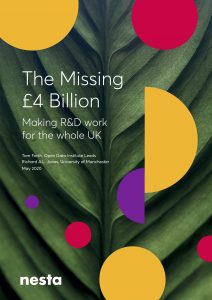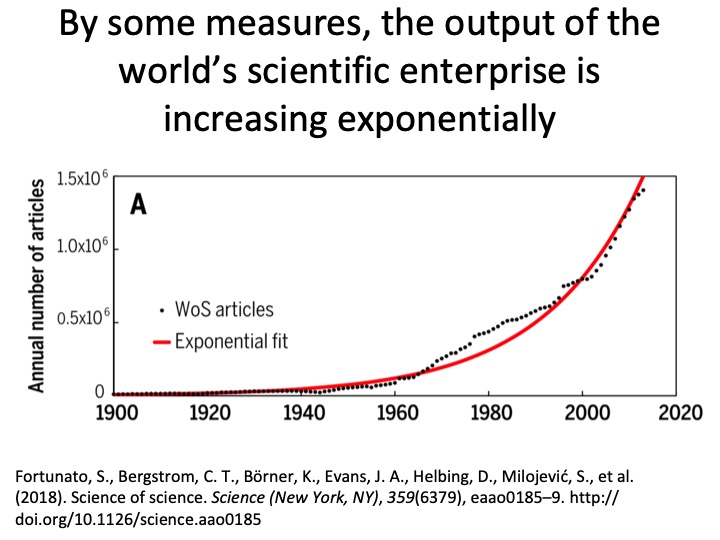This piece is based on talks I’ve given to present some of the arguments of the paper Tom Forth and I have just published with NESTA. The full paper is available here: The Missing £4 Billion: Making R&D work for the whole UK.
The UK is two countries, economically. In terms of productivity, “Greater South East England” – London, the South East and some of the East of England – is a country with a level of productivity comparable to richest parts of the rest of Northern Europe. But much of the rest of the UK – including the Midlands, the North, much of the Southwest of England, together with Wales and Northern Ireland – is more comparable to East Germany and Southern Italy in its productivity
The differences aren’t quite as stark when we look at living standards, because the UK runs an effective transfer union, where money generated in London and the South East is used to run the public services in the rest of the country. In terms of the balance between the tax and other revenues generated, and current government expenditure, only three regions of the UK put in more than they take out – the highly productive regions of London, the South East and the East of England.
The argument about “levelling up” economic performance across the country is often presented in terms of fairness. But we would have a fairer country if the Greater South East could keep more of the money it generates, while the rest of the country was able to pay its own way. A less economically unbalanced country would be both fairer and more prosperous.
But while the current expenditures of the less productive parts of the country are heavily subsidised by the greater South East, the opposite is the case for those types of investments that would enhance the productivity of the economically lagging regions. For investments like research and development, we spend the most money in exactly those regions that are already the most prosperous and productive. In effect, for many decades, we have been operating an anti-regional policy.
Currently, the regions and subregions containing London, Oxford and Cambridge account for 46 per cent of public and charitable R&D in the UK, with just 21 per cent of the population. Strikingly, public spending on R&D is even more concentrated than private sector spending.
By general agreement, the UK invests too little overall on R&D anyway. The nation’s R&D intensity – total spending on R&D, public and private, as a fraction of GDP – is 1.66 per cent, closer to countries like Italy and Spain than Germany or France, let alone innovation leaders like South Korea, with a total R&D spending of 4.55% of GDP. That’s why it’s welcome that the government has committed to increasing public spending on R&D to £22 billion a year by 2025, to get closer to the OECD average R&D intensity of 2.4%.
How much money would it take to increase R&D spending in the nations and regions to the level in greater South East England? To “level up” per capita investment right across the country would take a bit more than £4 billion a year – £1.6 billion would need to go to the North of England, £1.4 billion to the Midlands, £420 million to Wales, £580 million to South West England and £250 million to Northern Ireland, with spending in Scotland largely unchanged.
These are large numbers. The problem of regional R&D imbalances is a long-standing one, and there’s a tendency among some policy makers to say, “we’ve tried to solve this before and nothing’s worked”. The Regional Development Agencies in England spent about £100 million a year on innovation in the mid-2000’s. This did some useful things but was an order of magnitude too small to make a material difference. We failed in the past because we didn’t really try.
But in the context of a planned increase in R&D spending to £22 billion, given a current 20/21 budget for UKRI (the UK’s single research and innovation agency) of £8.4 billion (itself a substantial increase on earlier years, the necessary increases in the nations and regions are entirely feasible within the planned funding uplift.
Of course, it’s easy to spend money, but more difficult to do this well in a way that maximises the chances that it will lead to better economic outcomes for the whole of the UK, at the same time contributing to the nation’s wider goals. But there are some general guiding principles.
Firstly, we should follow the signals that the market sector gives us. Regions like the English Midlands and North West are characterised by private sector investment in R&D that is disproportionately large compared to the public sector investment. Here there are innovation systems that are strong already, but they need to be supported by public sector investment in the same way as happens in more prosperous Greater South East England. There is a more immediate crisis, here, as well. The impact of Covid-19 on the aerospace and automotive industries is a threat to these innovation systems, and we need to preserve the massive concentrations of know-how in companies like Rolls-Royce and JLR, and their suppliers.
Secondly, where we need to build innovation capacity in those parts of the country which are relatively weak in both public and private sector R&D, we should look to those entirely new industries and clusters we need to build up to meet future challenges. For example, we might want to ask, as we emerge from the current pandemic, whether the life sciences sector we have is right one to meet this kind of public health crisis.
This short term pandemic crisis shouldn’t blind us to the fact we’re immersed in the much longer term crisis of climate change. The government has signed up to a target of net zero greenhouse gas emissions by 2050. This implies a massive transition for our economy, which needs to be underpinned by innovation to make it affordable and achievable. We could be building a new hydrogen economy on Teeside and the Humber, deep sea floating offshore wind in the South West, next generation small modular reactors in Cumbria, all underpinned by research and innovation.
Thirdly, we need to break out of the trap that many of our towns and urban fringes have found themselves in, where low skills, low innovation and low productivity reinforce each other in a bad equilibrium leading to low wages and poor health outcomes. To break this cycle, we need at the same time to raise the demand for skills by attracting inward investment from technologically leading companies and driving up the innovative capacity of the existing business base, and create the supply of skills by a much more joined up approach between further and higher education. The creation of more Advanced Manufacturing Innovation Districts, like the one that’s grown up around the Advanced Manufacturing Research Centre in Rotherham, is one way to do this.
Different places have different problems, so there won’t a single solution. Our major cities outside the greater South East still underperform compared to second tier cities in France or Germany – agglomeration effects are important, but in the UK we don’t seem to be able to capture them fully. These cities need more R&D as part of a wider expansion of high value, knowledge intensive business services. Meanwhile some of the most intractable economic and social problems are to be found in the UK’s coastal and rural fringes – but more R&D probably isn’t the right recipe here. R&D is important, but it’s far from the only tool we have.
The UK’s economic imbalances are long-standing problems, that have been long recognised – and yet little progress has been made towards solving them. The UK’s highly centralised state is part of the problem. At this unique moment, where total R&D investment is planned to increase, we can rebalance R&D across the country without jeopardising the strong innovation systems of the greater South East, which remain a national asset.
A substantial fraction of the planned uplift in R&D spending should be devolved – to the devolved nations, and in England to cities and regions. This isn’t completely straightforward, because of the messy nature of the incomplete English devolution settlement. And it’s a fair comment that many cities and regions don’t yet have the capacity they need to make effective choices about how to spend R&D funds. But these aren’t reasons not to make the changes that are needed; they underline the need to take devolution further and develop that capacity.
To read the whole paper, see: The Missing £4 Billion: Making R&D work for the whole UK.

